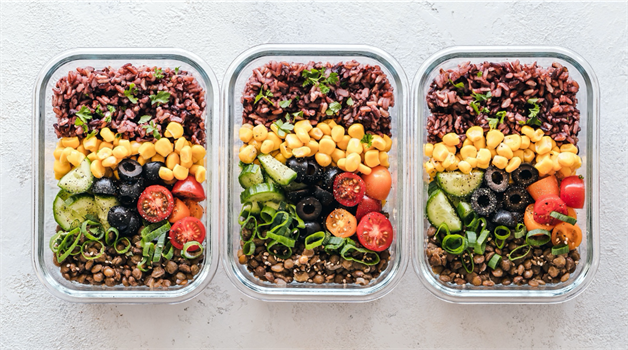Posted Apr 20, 2020

By Isabel Markowski, RDN, LDN
With current COVID-19 conditions, many of Chicago’s grocery store shelves have become ghost towns. As a registered dietitian, I always support fresh produce as the top-line of nutrition, frequenting Green City Market both as a vendor helper and shopper. However, working at a food pantry and being frugal to a fault, I know that shelf-stable foods can also be part of a well-balanced diet while being budget-friendly. The question is now, how do you make food last in order to limit trips to the store, but still put something nutritious and delicious on the table? The answer has three components: balancing nutrition, maximizing kitchen space, and personal preference.
Balanced nutrition can be complex or simple; let’s do simple. When you think of your plate, you want a variety of carbohydrates, protein, and fat or what we call macronutrients. Instead of just pasta (carbohydrates), add in sautéed vegetables (many are lower in all macronutrients, but high in micronutrients), ground turkey or beans (protein), and toss it in olive oil or a pesto (fat). That dish now has all macronutrients that work together to make you feel full and satisfied faster and for longer. Our bodies need all three to function best, so don’t be afraid of or favor just one. Balance also means variety, so try different vegetables or grains to get the widest range of micronutrients (aka vitamins, minerals, antioxidants, etc. that provide added benefits).
Next is maximizing kitchen space which includes your pantry, refrigerator and freezer. For your pantry, canned and dried goods are cheap and long-lasting. Locally-sourced, shelf stable foods are available through GCM Delivered or by ordering direct from local farmers at GCM’s Virtual Market. If you are at the store, just look for low-sodium, no added sugar, and 100% in juices (vs. syrup):
- Whole grains (brown rice, plain oats, whole grain pasta, cereal, popcorn kernels)
- Legumes (beans)
- Nuts/seeds (for snacking and toppings)
- Bread/tortillas (freeze to keep longer)
- Applesauce (unsweetened)
- Protein (chicken, quinoa, legumes)
- Oil (olive, grapeseed)
- Vegetables (pickled vegetables, tomatoes)
- Liquids (boxed milk, broth/stock)
To maximize refrigerator space, select long-lasting produce such as apples, broccoli, brussels sprouts, carrots, and cauliflower. You can still purchase shorter-lasting produce for variety, just plan to cook it first. You can then freeze those meals, so they’re ready-to-go later. Just let cool completely, fill a reusable container or wrap in beeswax paper, flatten in an even layer and lay flat in your freezer. Once you have multiple bags, you can stack them for better storage! Buying frozen vegetables and fruits is another terrific alternative to fresh as those purchased from GCM vendors are frozen during their peak season, meaning retained quality and nutrients. If you plan ahead, freezing your own vegetables and fruits is a great way to support farmers by buying in bulk from farmers markets. Try frozen spinach, broccoli, squash, or mixed berries.
The last component to tastefully and nutritiously stocking your kitchen is personal preference. You and I both know if there’s food you don’t like in your kitchen, you’re not going to eat it. Try new things, but build your foundation on things you already like. Find just 1-2 new recipes each week using a more unfamiliar vegetable in a different way (like blended into sauce or roasted with spices). Farmers cook with the foods they grow too, so talk to them for new ideas. Shaming yourself for not loving asparagus isn’t going to set you up for success. It’s knowing what you like and choosing the healthier, delicious versions of those foods that’ll get you through any pandemic, and you might even enjoy it.